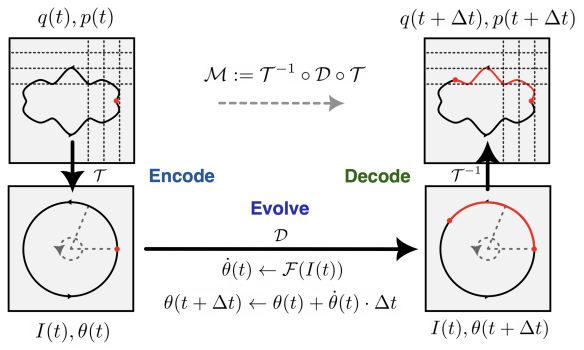Action-Angle Networks
Physics Insight
There is a subclass of Hamiltonian systems called Liouville integrable systems.
The Liouville-Arnold theorem guarantees that, for these systems, there exists a canonical transformation to a set of coordinates called Action-Angle coordinates, with which the phase space is greatly simplified and allowing for easier prediction.
The Architecture
Daigavane et al.1 introduce Action-Angle networks, an architecture that takes advantage of the linear evolution of the angle variable for Liouville-Arnold theorem to evolve the system forward in time.
The paper adopts an autoencoder-type architecture:
- Encode step: they use a GSympNet2 network to do the canonical transformation from to ,
- Evolve step: they take advantage of the fact that the angle coordinate evolves linearly with time to use the Euler update rule to get *, and
- Decode step: they use the inverse of the GSympNet network to go back to position-momentum at the new time step
N.B.: GSympNets are very easily invertible by just reserving order of the gradient modules and negating their learnable parameters. For more details, check again2
*: the (used in the Euler update rule in the evolve step) is approximated using a multi-layer perceptron.
This is the schematic of the architecture (image taken from the paper1):

The loss function of the action-angle network has the following two terms:
- , and
- (this term is to enforce the constancy of the action variable),
where is the training data composed of position and momentum data for a number of time steps.
Daigavane, A., Kosmala, A., Cranmer, M., Smidt, T., & Ho, S. (2022). Learning Integrable Dynamics with Action-Angle Networks. https://arxiv.org/abs/2211.15338
Jin, P., Zhang, Z., Zhu, A., Tang, Y., & Karniadakis, G. E. (2020). SympNets: Intrinsic structure-preserving symplectic networks for identifying Hamiltonian systems. https://arxiv.org/abs/2001.03750 jin2020 SympNets